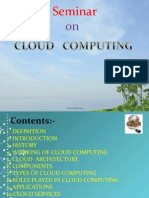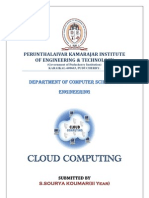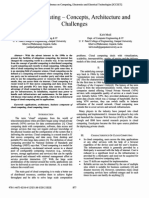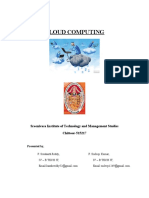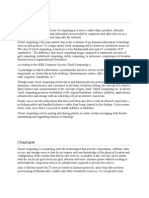Harshvardhan Saini: Cloud Computing
Uploaded by
Harshvardhan SainiHarshvardhan Saini: Cloud Computing
Uploaded by
Harshvardhan SainiCloud Computing
Harshvardhan Saini
B.Tech. final year, IT Sri Balaji College of Engg. & Tech. Jaipur-302013, India
harsu90@gmail.com
Abstract
Cloud computing also known as internet cloud offering utility oriented IT services to users worldwide. Cloud computing is the delivery of computing as a service rather than a product, whereby shared resources, software and information are provided to computers and other devices as a utility over a network (typically the Internet). . It enables hosting of applications from consumer, scientific and business domains. The data centers hosting cloud computing applications consume huge amounts of energy contributing to high operational costs and carbon footprints to the environment. With cloud computing, you eliminate those headaches because youre not managing hardware and softwarethats the responsibility of an experienced vendor. The shared infrastructure means it works like a utility: You only pay for what you need, upgrades are automatic, and scaling up or down is easy. The concept of cloud computing fills a perpetual need of IT: a way to increase capacity or add capabilities on the fly without investing in new infrastructure, training new personnel, or licensing new software. Keywords: Cloud, Hybrid cloud, Public cloud, Private cloud.
INTRODUCTION
Cloud computing provides computation, software, data access, and storage services that do not require end-user knowledge of the physical location and configuration of the system that delivers the services. Parallels to this concept can be drawn with the electricity grid, where in end-users consume power without needing to understand the component devices or infrastructure required to provide the service. Cloud computing describes a new supplement, consumption, and delivery model for IT services based on Internet protocols, and it typically involves provisioning of dynamically scalable and often virtualized resources. It is a byproduct and consequence of the ease-of-access to remote computing sites provided by the Internet. This may take the form of web-based tools or applications that users can access and use through a web browser as if they were programs installed locally on their own computers. Cloud computing providers deliver applications via the internet, which are accessed from a Web browser, while the business software and data are stored on servers at a remote location. In some cases, legacy applications (line of business applications that until now have been prevalent in thin client Windows computing) are delivered via a screen-sharing technology, while the computing resources are consolidated
at a remote data center location; in other cases, entire business applications have been coded using web-based technologies such as AJAX. Most cloud computing infrastructures consist of services delivered through shared datacenters and appearing as a single point of access for consumers' computing needs. Commercial offerings may be required to meet service level agreements (SLAs), but specific terms are less often negotiated by smaller companies
CLOUD COMPUTING:
Cloud computing is an internet (CLOUD) based development and use of computer technology (COMPUTING). Cloud computing is a general term for anything that involves delivering hosted services over the Internet. It is used to describe both a platform and type of application. Cloud computing also describes applications that are extended to be accessible through the Internet. These cloud applications use large data centers and powerful servers that host web applications and web services. Any with a suitable Internet connection and a standard browser can access a cloud application.
History
The Cloud is a metaphor for the Internet, derived from its common depiction in network diagrams (or more generally components which are managed by others) as a cloud outline. The underlying concept dates back to 1960 when John McCarthy opined that "computation may someday be organized as a public utility" (indeed it shares characteristics with service bureaus which date back to the 1960s) and the term The Cloud was already in commercial use around the turn of the 21st century. Cloud computing solutions had started to appear on the market, though most of the focus at this time was on Software as a service.
2007 saw increased activity, including Goggle, IBM and a number of universities embarking on a large scale cloud computing research project, around the time the term started gaining popularity in the mainstream press. It was a hot topic by mid-2008 and numerous cloud computing events had been scheduled.
WHAT IS DRIVING CLOUD COMPUTING?
The CLOUD COMPUTING is driving in two types of categories .They are as follows: 1. Customer perspective 2. Vendor perspective Customer perspective: In one word: economics Faster, simpler, cheaper to use cloud computation. No upfront capital required for servers and storage. No ongoing for operational expenses for running datacenter. Application can be run from anywhere. Vendor perspective: Easier for application vendors to reach new customers. Lowest cost way of delivering and supporting applications. Ability to use commodity server and storage hardware. Ability to drive down data center operational cots. Types of services: These services are broadly divided into three categories: Infrastructure-as-a-Service (IaaS) Platform-as-a-Service (PaaS) Software-as-a-Service (SaaS).
Infrastructure-as-a-Service (IaaS):
Infrastructure-as-a-Service (IaaS) like Amazon Web Services provides virtual servers with unique IP addresses and blocks of storage on demand. Customers benefit from an API from which they can control their servers. Because customers can pay for exactly the amount of service they use, like for electricity or water, this service is also called utility computing. Platform-as-a-Service (PaaS): Platform-as-a-Service (PaaS) is a set of software and development tools hosted on the provider's servers. Developers can create applications using the provider's APIs. Google Apps is one of the most famous Platform-as-a-Service providers. Developers should take notice that there aren't any interoperability standards (yet), so some providers may not allow you to take your application and put it on another platform. Software-as-a-Service (SaaS):
Software-as-a-Service (SaaS) is the broadest market. In this case the provider allows the customer only to use its applications. The software interacts with the user through a user Interface. These applications can be anything from web based email, to applications like Twitter or Last.fm. Types by visibility: Public cloud: Public cloud or external cloud describes cloud computing in the traditional mainstream sense, whereby resources are dynamically provisioned on a fine-grained, self-service basis over the Internet, via web applications/web services, from an off-site third-party provider who shares resources and bills on a fine-grained utility computing basis. Hybrid cloud: A hybrid cloud environment consisting of multiple internal and/or external providers] "will be typical for most enterprises". A hybrid cloud can describe configuration combining a local device, such as a Plug computer with cloud services. It can also describe configurations combining virtual and physical, collocated assetsfor example, a mostly virtualized environment that requires physical servers, routers, or other hardware such as a network appliance acting as a firewall or spam filter. Private cloud: Private cloud and internal cloud are neologisms that some vendors have recently used to describe offerings that emulate cloud computing on private networks. These (typically virtualization automation) products claim to "deliver some benefits of cloud computing without the pitfalls", capitalizing on data security, corporate governance, and reliability concerns. They have been criticized on the basis that users "still have to buy, build, and manage them" and as such do not benefit from lower up-front capital costs and less handson management[, essentially "[lacking]the economic model that makes cloud computing such an intriguing concept".
How does cloud computing work?
Supercomputers today are used mainly by the military, government intelligence agencies, Universities and research labs, and large companies to tackle enormously complex Calculations for such tasks as simulating nuclear explosions, predicting climate change, designing airplanes, and analyzing which proteins in the body are likely to bind with potential new drugs. Cloud computing aims to apply that kind of powermeasured in the tens of trillions of computations per secondto problems like analyzing risk in financial portfolios, delivering personalized medical information, even powering immersive computer games, in a way that users can tap through the Web. It does that by networking large groups of servers that often use low-cost consumer PC technology, with specialized connections to spread data-processing chores across them. By contrast, the newest and most powerful desktop PCs process only about 3 billion computations a second. Let's say you're an executive at a large corporation. Your particular responsibilities include making sure that all of your employees have the right hardware and software they need to do their jobs. Buying computers for everyone isn't enough -- you also have to purchase software or software licenses to give employees the tools they require. Whenever you have a new hire, you have to buy more software or make sure your current software license allows another user. It's so stressful that you find it difficult to go.
Applications:
REFERENCES: "The Internet Cloud" Thestandard.com. Retrieved 2010-08-22 "IBM, Google Team on an Enterprise Cloud." May 2008. Rich Miller Retrieved 201004-01". DataCenterKnowledge.com. 2008-05-02. Retrieved 2010-08-22. http://en.wikipedia.org/wiki/Cloud_computing Web guild.org: http://www.webguild.org/ How stuff works.com: http://communication.howstuffworks.com/ Cloud security.org: http://cloudsecurity.org IBM: http://www.ibm.com/developerworks/websphere/zones/hipods/
You might also like
- Business Implementation of Cloud ComputingNo ratings yetBusiness Implementation of Cloud Computing6 pages
- Cloud Computing: Perunthalaivar Kamarajar Institute of Engineering & TechnologyNo ratings yetCloud Computing: Perunthalaivar Kamarajar Institute of Engineering & Technology15 pages
- Internet: It Is Used To Describe Both ANo ratings yetInternet: It Is Used To Describe Both A11 pages
- A Brief Introduction To Cloud Computing: Iaas (Infrastructure As Service)No ratings yetA Brief Introduction To Cloud Computing: Iaas (Infrastructure As Service)4 pages
- Iaas Paas) Saas Flowchart: As A Service (Saas)No ratings yetIaas Paas) Saas Flowchart: As A Service (Saas)4 pages
- Cloud Computing - Concepts, Architecture and Challenges: Yashpalsinh Jadeja Kirit ModiNo ratings yetCloud Computing - Concepts, Architecture and Challenges: Yashpalsinh Jadeja Kirit Modi4 pages
- Assignment On Benefits of Cloud ComputingNo ratings yetAssignment On Benefits of Cloud Computing8 pages
- Cloud Computing: Challenges and Proposed Techniques To Address ProblemsNo ratings yetCloud Computing: Challenges and Proposed Techniques To Address Problems15 pages
- Module 1 - Introduction To Cloud ComputingNo ratings yetModule 1 - Introduction To Cloud Computing22 pages
- Abstract-: Keywords: Applications, Architecture, Business Component of CloudNo ratings yetAbstract-: Keywords: Applications, Architecture, Business Component of Cloud15 pages
- Cloud Computing: Sreenivasa Institute of Technology and Management Studies Chittoor-515217No ratings yetCloud Computing: Sreenivasa Institute of Technology and Management Studies Chittoor-51521716 pages
- Cloud Computing: Cloud Computing Is The Delivery of Computing As A Service Rather Than A Product, WherebyNo ratings yetCloud Computing: Cloud Computing Is The Delivery of Computing As A Service Rather Than A Product, Whereby15 pages
- Cloud Computing Technology: Master of Computer ApplicationNo ratings yetCloud Computing Technology: Master of Computer Application24 pages
- Cloud Computing: An Overview: Charandeep Singh Bedi, Rajan SachdevaNo ratings yetCloud Computing: An Overview: Charandeep Singh Bedi, Rajan Sachdeva10 pages
- Cloud Computing Is The Delivery Of: ComparisonsNo ratings yetCloud Computing Is The Delivery Of: Comparisons10 pages
- Cloud Computing Made Simple: Navigating the Cloud: A Practical Guide to Cloud ComputingFrom EverandCloud Computing Made Simple: Navigating the Cloud: A Practical Guide to Cloud ComputingNo ratings yet
- Cloud Computing: Harnessing the Power of the Digital Skies: The IT CollectionFrom EverandCloud Computing: Harnessing the Power of the Digital Skies: The IT CollectionNo ratings yet
- Cloud: Get All The Support And Guidance You Need To Be A Success At Using The CLOUDFrom EverandCloud: Get All The Support And Guidance You Need To Be A Success At Using The CLOUDNo ratings yet
- Cloud computing: Moving IT out of the officeFrom EverandCloud computing: Moving IT out of the officeBCS, The Chartered Institute for ITNo ratings yet
- The Cloud Computing Revolution: From Virtualization to Automation: Unveiling the Cloud Computing RevolutionFrom EverandThe Cloud Computing Revolution: From Virtualization to Automation: Unveiling the Cloud Computing RevolutionNo ratings yet
- AWS: The Ultimate Guide From Beginners To Advanced For The Amazon Web Services (2020 Edition)From EverandAWS: The Ultimate Guide From Beginners To Advanced For The Amazon Web Services (2020 Edition)2/5 (1)
- The Ultimate Guide to Unlocking the Full Potential of Cloud Services: Tips, Recommendations, and Strategies for SuccessFrom EverandThe Ultimate Guide to Unlocking the Full Potential of Cloud Services: Tips, Recommendations, and Strategies for SuccessNo ratings yet
- 4.1 C H A P T E R - 4 - Defining Scope, Quality, Responsibility, and Activity SequenceNo ratings yet4.1 C H A P T E R - 4 - Defining Scope, Quality, Responsibility, and Activity Sequence25 pages
- Actual vs. Budget Ytd Year 2021: G/L Code Account Title Actual Budget Remaining $ Remaining %No ratings yetActual vs. Budget Ytd Year 2021: G/L Code Account Title Actual Budget Remaining $ Remaining %4 pages
- FEANOR Update of ZEISS ULM Aus Jena Lenght Measurement Machines With QMSOFTNo ratings yetFEANOR Update of ZEISS ULM Aus Jena Lenght Measurement Machines With QMSOFT17 pages
- Paper Dissection Lab - Playdough Mats A4 TwinkleNo ratings yetPaper Dissection Lab - Playdough Mats A4 Twinkle6 pages
- Case 3 - Cirque Du Soleils Information Technology InitiativesNo ratings yetCase 3 - Cirque Du Soleils Information Technology Initiatives14 pages
- 78788417 TIA Portal Und PLCSIM Advanced in Der Virtuellen Maschine EnNo ratings yet78788417 TIA Portal Und PLCSIM Advanced in Der Virtuellen Maschine En11 pages
- Eastern Coalfields Limited Mining Sirdar Posts NotificationNo ratings yetEastern Coalfields Limited Mining Sirdar Posts Notification5 pages
- Dimetra R8.2 Configuration and Administration Tasksheet (Student) v1.5 PDFNo ratings yetDimetra R8.2 Configuration and Administration Tasksheet (Student) v1.5 PDF20 pages
- VAPT Information (Nandi Infrastructure Corridor Enterprise LTD)No ratings yetVAPT Information (Nandi Infrastructure Corridor Enterprise LTD)5 pages
- Archived: Asphalt Mixture Design IllustratedNo ratings yetArchived: Asphalt Mixture Design Illustrated80 pages
- Experiment No.3 Discrete-Time Convultion and Z-Transform Procedure A: Convolution of Discrete-Time Signal0% (1)Experiment No.3 Discrete-Time Convultion and Z-Transform Procedure A: Convolution of Discrete-Time Signal7 pages
- Cloud Computing: Perunthalaivar Kamarajar Institute of Engineering & TechnologyCloud Computing: Perunthalaivar Kamarajar Institute of Engineering & Technology
- A Brief Introduction To Cloud Computing: Iaas (Infrastructure As Service)A Brief Introduction To Cloud Computing: Iaas (Infrastructure As Service)
- Cloud Computing - Concepts, Architecture and Challenges: Yashpalsinh Jadeja Kirit ModiCloud Computing - Concepts, Architecture and Challenges: Yashpalsinh Jadeja Kirit Modi
- Cloud Computing: Challenges and Proposed Techniques To Address ProblemsCloud Computing: Challenges and Proposed Techniques To Address Problems
- Abstract-: Keywords: Applications, Architecture, Business Component of CloudAbstract-: Keywords: Applications, Architecture, Business Component of Cloud
- Cloud Computing: Sreenivasa Institute of Technology and Management Studies Chittoor-515217Cloud Computing: Sreenivasa Institute of Technology and Management Studies Chittoor-515217
- Cloud Computing: Cloud Computing Is The Delivery of Computing As A Service Rather Than A Product, WherebyCloud Computing: Cloud Computing Is The Delivery of Computing As A Service Rather Than A Product, Whereby
- Cloud Computing Technology: Master of Computer ApplicationCloud Computing Technology: Master of Computer Application
- Cloud Computing: An Overview: Charandeep Singh Bedi, Rajan SachdevaCloud Computing: An Overview: Charandeep Singh Bedi, Rajan Sachdeva
- Cloud Computing Made Simple: Navigating the Cloud: A Practical Guide to Cloud ComputingFrom EverandCloud Computing Made Simple: Navigating the Cloud: A Practical Guide to Cloud Computing
- Cloud Computing: Harnessing the Power of the Digital Skies: The IT CollectionFrom EverandCloud Computing: Harnessing the Power of the Digital Skies: The IT Collection
- Cloud: Get All The Support And Guidance You Need To Be A Success At Using The CLOUDFrom EverandCloud: Get All The Support And Guidance You Need To Be A Success At Using The CLOUD
- Cloud computing: Moving IT out of the officeFrom EverandCloud computing: Moving IT out of the office
- The Cloud Computing Revolution: From Virtualization to Automation: Unveiling the Cloud Computing RevolutionFrom EverandThe Cloud Computing Revolution: From Virtualization to Automation: Unveiling the Cloud Computing Revolution
- AWS: The Ultimate Guide From Beginners To Advanced For The Amazon Web Services (2020 Edition)From EverandAWS: The Ultimate Guide From Beginners To Advanced For The Amazon Web Services (2020 Edition)
- The Ultimate Guide to Unlocking the Full Potential of Cloud Services: Tips, Recommendations, and Strategies for SuccessFrom EverandThe Ultimate Guide to Unlocking the Full Potential of Cloud Services: Tips, Recommendations, and Strategies for Success
- 4.1 C H A P T E R - 4 - Defining Scope, Quality, Responsibility, and Activity Sequence4.1 C H A P T E R - 4 - Defining Scope, Quality, Responsibility, and Activity Sequence
- Actual vs. Budget Ytd Year 2021: G/L Code Account Title Actual Budget Remaining $ Remaining %Actual vs. Budget Ytd Year 2021: G/L Code Account Title Actual Budget Remaining $ Remaining %
- FEANOR Update of ZEISS ULM Aus Jena Lenght Measurement Machines With QMSOFTFEANOR Update of ZEISS ULM Aus Jena Lenght Measurement Machines With QMSOFT
- Case 3 - Cirque Du Soleils Information Technology InitiativesCase 3 - Cirque Du Soleils Information Technology Initiatives
- 78788417 TIA Portal Und PLCSIM Advanced in Der Virtuellen Maschine En78788417 TIA Portal Und PLCSIM Advanced in Der Virtuellen Maschine En
- Eastern Coalfields Limited Mining Sirdar Posts NotificationEastern Coalfields Limited Mining Sirdar Posts Notification
- Dimetra R8.2 Configuration and Administration Tasksheet (Student) v1.5 PDFDimetra R8.2 Configuration and Administration Tasksheet (Student) v1.5 PDF
- VAPT Information (Nandi Infrastructure Corridor Enterprise LTD)VAPT Information (Nandi Infrastructure Corridor Enterprise LTD)
- Experiment No.3 Discrete-Time Convultion and Z-Transform Procedure A: Convolution of Discrete-Time SignalExperiment No.3 Discrete-Time Convultion and Z-Transform Procedure A: Convolution of Discrete-Time Signal
